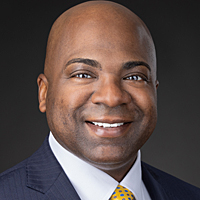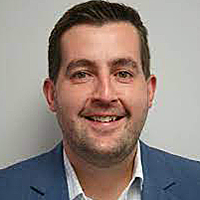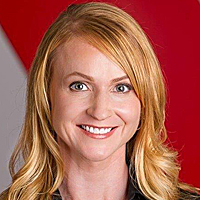WSOC’s ‘Get Real’ Project Tackles The Thorniest Issues Head On

Cedric Thomas
Five years ago, leadership and staff at WSOC, the Cox-owned ABC affiliate that serves the Charlotte, N.C., metropolitan area, organized an event to distribute food to homeless locals. Cedric Thomas, whom Cox had hired as the station’s VP and GM a few months earlier, was shocked at the turnout.
The parking lot in which the event was held — one that happened to be located across the street from Thomas’s home — quickly filled to near capacity.
But on that Saturday Thomas wasn’t taken aback by just the sheer numbers of people in need of help. “I went to talk to some of the people in the cars, and I noticed it was families,” Thomas says. “It was nurses, it was teachers.”
They were not the kinds of individuals one would expect to be experiencing homelessness, he thought to himself. Many were professionals who were having a significant impact on the lives of others throughout the community.
Thomas told his news director, Mike Oliveira, an even more-recent WSOC hire than Thomas, about the experience. He then asked him to produce stories about Charlotte’s apparent affordable housing crisis.

Mike Oliveira
“That’s not the most visual [topic] in the world,” Oliveira quips, “but Cedric’s really, really good about challenging us to do the important thing, the hard thing, the thing that’s important to the community.”
It wound up being the start of a very big thing for WSOC. One story about affordable housing turned into two, then four and, to date, the station has produced at least three dozen pieces on the topic, culminating in the recent WSOC series Priced Out of Charlotte.
On the strength of those stories, the news team at WSOC decided to test their reporting mettle further and cover more subjects that, as Oliveira describes them, “are the most important things, that impact the most people, that are very often the hardest to talk about.” In their estimation such topics included “race equality” and the “mental health hidden crisis,” to quote titles of two additional series, now all part of an overarching programming initiative called Get Real.
“We’ve gotten very comfortable being uncomfortable,” Oliveira says. That unsettled energy, he says, turns an ordinary story into a Get Real story.
WSOC’s purposefully friction-filled approach to investigative reporting also leans heavily into human interest stories and solutions-based journalism. There’s the piece about a young woman who was diagnosed with obsessive compulsive disorder at the age of 18, after dealing with symptoms starting at 6. Due in large part to the delayed diagnosis, doctors believe she may never mature into a fully functioning adult.
Another story in the WSOC series about affordable housing spotlights a unique shelter that provides long-term assistance to single women in need. Under the “racial equality” banner there’s an interview with Black police officers who address a bevy of hot button issues.

Deirdre Conley,
Deirdre Conley, creative services director at WSOC, says stories like these from Get Real are the byproduct of the station having given viewers “a voice” and allowed organic discourse to take shape.
“Get Real is valuable to the viewers because it gives them a platform to talk through the tough issues affecting the community,” she says. “We as a station can amplify voices that might not otherwise be heard. It also allows others going through the same issue to see they are not alone. We wouldn’t be living our brand if we ignored these issues or ran a story and moved on.”
When asked what may be the most innovative aspect of WSOC’s Get Real programming, Oliveira and Thomas do not point toward any special technology that they use to produce the stories. They didn’t build out a new, ambitious investigative unit. The station simply diverted already existing resources to support the producers.
Aside from the hard-hitting nature of the chosen topics, Oliveira and Thomas say that what makes Get Real’s pieces fresh and cutting edge is a collective dedication to telling stories in the best way possible. Sometimes that means smashing through traditional broadcast news time constraints.
The segment about the long-term shelter for single women clocked in at a tidy 104 seconds, fitting perfectly into the traditional nightly news. “A Conversation with Black Officers,” on the other hand, earned its own hour-long special. Other WSOC Get Real stories have runtimes everywhere in between, airing in various newscast blocks or as standalone specials.
“If you’re telling a story, and you’re trying to help someone through a mental health issue, there’s no time [limit] on that,” Thomas says. “You do what you need to do to make sure people are taken care of and your community’s healthier after you finish.”
In that respect, WSOC goes the extra mile, setting up phone banks after Get Real programs that the team believes will inspire viewers to seek assistance with whatever related issues they may be dealing with. Research shows such initiatives prove useful, Oliveira says, though, really, he says WSOC’s personnel just want to do “the right thing.”
“We all live here, too,” he continues. “So, that kind of solution-oriented community impact outlook on this is what made it so successful…. When you hear the phones ringing all night, and people are calling with very serious issues, you at least feel like that day you went to work you did something that really help[ed] somebody out.”
Get Real is actually a Cox-wide programming initiative, but it was launched after WSOC had begun to produce the types of stories that now fall underneath its umbrella. The station has retroactively branded relevant past stories with the Get Real banner.
Oliveira says the audience response to WSOC’s Get Real segments and specials are generally very positive — after they air. When the station runs advertisements for their upcoming reports, however, people often take to social media to voice their discomfort with the subject matter.
“The promo gets everybody riled up all the time,” Oliveira says. “But that’s because they haven’t seen [the program] and they make assumptions about what you’re doing.”
The ads are getting the job done, though. Oliveira says WSOC Get Real standalone shows typically rank first or second in the market during their given airtime slots and earn particularly strong ratings in the crucial 25-54 age demographic.
More importantly to Thomas, the stories in Get Real “open up real dialogue,” he says.
“I go to restaurants just to hear what people are saying,” Thomas says. “I heard people actually talking about it, and what that meant to them and their families. And that was really great.”
Editor’s Note: This is the latest of TVNewsCheck’s “Newsroom Innovators” profiles, a series showcasing people and news organizations evolving the shape and substance of video reporting. These profiles examine the inception of their innovations, the tools they employ and how they’re reconciling experimental approaches to news storytelling within daily workflows. You can find the others here.
























Comments (0)